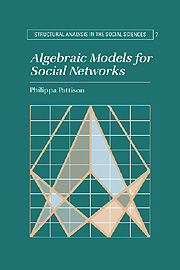Book contents
- Frontmatter
- Contents
- List of figures and tables
- Preface
- 1 Algebraic representations for complete social networks
- 2 Algebraic representations for local social networks
- 3 Comparing algebraic representations
- 4 Decompositions of network algebras
- 5 An analysis for complete and local networks
- 6 Time-dependent social networks
- 7 Algebras for valued networks
- 8 Issues in network analysis
- References
- Appendix A Some basic mathematical terms
- Appendix B Proofs of theorems
- Author index
- Subject index
2 - Algebraic representations for local social networks
Published online by Cambridge University Press: 21 October 2009
- Frontmatter
- Contents
- List of figures and tables
- Preface
- 1 Algebraic representations for complete social networks
- 2 Algebraic representations for local social networks
- 3 Comparing algebraic representations
- 4 Decompositions of network algebras
- 5 An analysis for complete and local networks
- 6 Time-dependent social networks
- 7 Algebras for valued networks
- 8 Issues in network analysis
- References
- Appendix A Some basic mathematical terms
- Appendix B Proofs of theorems
- Author index
- Subject index
Summary
Although a large number of significant network studies have involved complete networks of the kind discussed so far, there is also considerable interest in the analysis of personal, or ego-centred, networks arising from survey research (e.g., Feiring & Coates, 1987; Fischer, 1982; Fischer et al., 1977; Henderson et al., 1981; Laumann, 1973). An indication of the extent of this interest was the decision to include a set of network questions in the General Social Survey (GSS) from 1985 (Burt, 1984). As a result of that decision, it is now easier for social scientists to address a variety of questions about the links between network and other personal and social characteristics using GSS data (e.g., Bienenstock, Bonacich & Oliver, 1990; Burt, 1986b, 1987a, 1987b; Burt & Guilarte, 1986; Huang & Tausig, 1990; Marsden, 1986, 1988).
It is usual in survey studies to sample a number of individuals from some population of interest and to enquire about characteristics of their “local” networks. For instance, the GSS network questions seek information about those people with whom an individual has discussed an important personal matter in the preceding six months, as well as information about the interrelations of those people. Symmetric relational data for two types of relations in the local network are obtained: (a) who is acquainted with whom (or, equivalently, who is a stranger to whom) and (b) who is “especially close” to whom (Burt, 1984).
- Type
- Chapter
- Information
- Algebraic Models for Social Networks , pp. 56 - 89Publisher: Cambridge University PressPrint publication year: 1993



